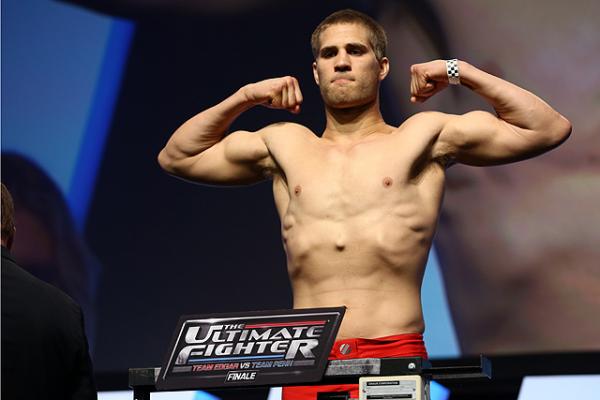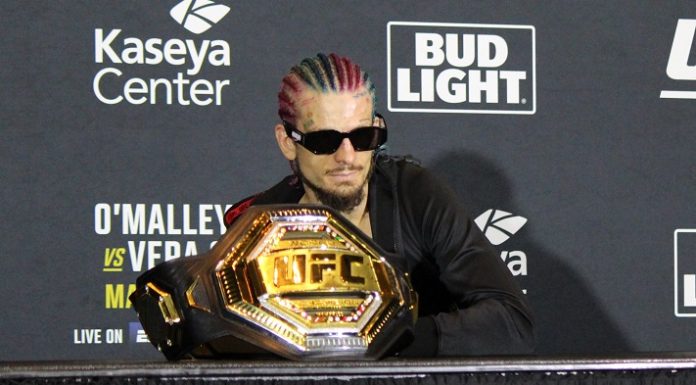
The Wrestling to MMA crossover works both ways, as has been evident of late as a handful of UFC/MMA athletes have tried out for the WWE.
Matt Van Buren. Derrick Mehmen. Juan Adams. Michael Lilly. You may or may recognize some of those names. One is a TUF finalist. Another fought in Strikeforce. A third is an undefeated LFA prospect. And all recently tried out for the WWE. Alongside them were a number of amateur wrestlers and other athletes. “Real” martial artists. So why are so many MMA athletes suddenly trying out for the WWE?
To be fair, let’s admit that this is not exactly new — and maybe it’s just under the microscope more now that Ronda Rousey has signed on with the wrestling promotion. WWE, and pro wrestling in general, has a long history with MMA, one that some fans either abhor, or like to pretend doesn’t exist. Yet it dates back to the modern beginnings of the sport, with names like Ken Shamrock, Dan Severn, and Sakuraba. And while the casual viewer will think of names like Brock Lesnar and CM Punk jumping over to the UFC, any number of pro wrestlers have dabbled in MMA. Everyone from Dave Batista to Bobby Lashley to the late Sean O’Haire gave MMA a whirl. And while Lesnar remains the most successful, other wrestlers have found differing levels of success. Most recently, Jake Hager, a.k.a. Jack Swagger, signed on with Bellator, with his debut planned for later this year.
Yet rarely have we seen high profile crossovers going the other way (especially when you consider that fighters like Shamrock were technically wrestlers first). Rousey is unquestionably the highest-profile fighter to make the jump, and likely the highest profile athlete since Olympic gold medal winner Kurt Angle back in the 90s.
Yet while the attraction for Rousey is obvious (she’s a lifelong wrestling fan who will get a good payday thanks to her mainstream popularity, waning as it might be), the allure for lesser-known fighters is a little more surprising. Until, that is, you factor in the realities of the fight game.
Seemingly trapped in time, the base salary for an entry-level fighter in the UFC, one who is virtually unknown, remains $10,000. That’s $10,000 to show, and then another $10,000 to win. There have been variations, but that’s what Davis Ramos and Alex Perez earned for their respective wins at UFC Fresno last December, as disclosed by the CSAC. 10k to show, 10k to win. Luckily both won, which resulted in a $20,000 payday for each.
Of course, that’s minus a few deductions. Which include taxes, training camp costs, travel expenses (the UFC generally pays the travel expenses for a fighter and one cornerman, but most fighters have more than one), and whatever cut their agent gets.
Since UFC fighters are considered independent contractors (despite being denied the ability to obtain their own sponsors, as golfers, tennis players, and other individual athletes can), they also lack comprehensive health coverage and a pension plan. So consider those as additional deductions (possibly).
The end result — being an entry-level fighter is a crap shoot. Even being a mid-card fighter isn’t exactly a financial windfall in many cases. Let’s go back to that Fresno card from December. Liz Carmouche, who fought against Rousey for the inaugural UFC women’s bantamweight championship, made a whopping $30,000 — in a loss, but that’s still a questionable level of pay for a former title contender.
At the top of the MMA game are stars like Conor McGregor and Georges St. Pierre, of course. Yet it’s the mid-card level fighters who are now seen taking a renewed interest in the scripted world of the WWE. And while you might argue that the four names we opened with (Van Buren, Mehmen, Lilly, Adams) are far from a trend, they’re far from alone. Ronda Rousey’s four horsewomen stable has dabbled in pro wrestling, and Shayna Baszler has already found some success in the pro wrestling circuit. She held her own in the WWE-backed Mae Young Classic, and will likely be a part of Rousey’s WWE program.
UFC alum Matt Riddle has also had a solid showing in pro wrestling. Riddle and Dana White never saw eye-to-eye, and his drug test violations for marijuana didn’t help his MMA career. Yet he was a fan favorite who almost always put on a show; even outside the UFC, Riddle had options. Stephan Bonnar, Phil Baroni, and others are giving it a shot as well. Bonnar and Baroni’s best days in MMA are behind them, but a fighter like Riddle, a popular banger in the UFC, is another matter. So too is Juan Adams, undefeated in LFA — and as an amateur. It’s clear the allure of a steady paycheck is a big factor in their transition, and that is something the UFC needs to think on.
Consider that, all the way back in 2000, the WWE was paying Raven — a solid veteran, but not exactly headlining WrestleMania — $75,000 for the year, which doubled the following year, and rose to $200,000 in the third year of his contract and beyond. That’s per a 2015 Forbes report examining salaries of WWE performers. The bottom line is that for some, fixed money is going to be a greater attraction than the questionable starting salary of MMA’s premiere promotion. Beyond that, the a mid-level WWE wrestler has a better upside than a mid-level fighter in many cases, especially when you consider that every WWE wrestler is a “SuperStar.”
Maybe Van Buren says it best:
I really would like to know how a lot of fighters making no money can afford to train twice a day.
— Matt Van Buren (@GutterMMA) February 10, 2018
This isn’t the first batch of mixed martial artists to try out for the WWE. It won’t be the last. Yet while the question of fighter pay remains one of the key issues in the MMA world in 2018, it feels as if more and more prospects, mid-card fighters, and veterans might just try their hand at a job that seemingly offers better benefits and a more lucrative career.



















